L | A (Translated with ChatGPT)
By Taozi Jiang
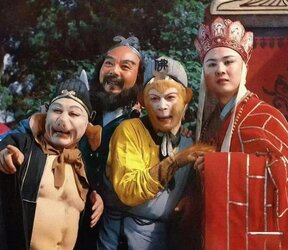
Even those who don’t play games know that another “Wukong” has emerged—“You must have all heard the stories about him. Some say he helped the Tang monk obtain the true scriptures and was granted the title of Victorious Fighting Buddha, remaining in the Lingshan Mountains from then on.
Others say that the one who became a Buddha was not him at all; the real Wukong had long died on the journey to the West. Still, others say that 'Journey to the West' never actually happened; he is just a monkey invented by the storyteller.
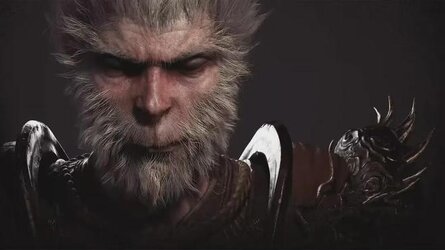
Domestic AAA game masterpiece "Black Myth: Wukong"
This passage comes from the domestic AAA game masterpiece "Black Myth: Wukong." One of the effects of the game's popularity is the increase in reading the original "Journey to the West": on WeChat Reading, both "Journey to the West" and the book "Wukong Biography" by Jin Hezai have topped the trending list; on Amazon, the sales of the English version of "Journey to the West" have rapidly increased.
If we accept the claim that the original hundred-chapter edition of "Journey to the West" appeared during the early Jiajing period of the Ming Dynasty, then "Journey to the West" has been established for at least 500 years.
The "Journey" story, which took shape 500 years ago, especially the vibrant image of Sun Wukong, continues to resonate in modern and post-modern contexts through various media such as film and television, fan fiction, anime, and games. This is enough to demonstrate that this IP has a thriving cultural vitality.
True Heroism
The story of "Journey to the West" begins with the stone monkey, born from the "essence of heaven and earth," leaping over a waterfall and discovering the Water Curtain Cave in the Flower-Fruit Mountain paradise.
Just like Harry Potter passing through Platform 9¾ to enter the magical world from the real world, the stone monkey's leap foreshadows that readers are about to enter not the era of the Tang monk Xuanzang, the prototype of Tang Sanzang, but a mythical world where humans coexist with demons, spirits, ghosts, immortals, Buddhas, and gods.
Since it is a mythical world, where characters possess various supernatural powers, it allows for boundless imagination, providing space for future adaptations into visual forms. While this mythical world may seem ethereal and elusive, it is, in fact, a reflection of the secular world.
As Lu Xun said, “both gods and demons possess human emotions, and spirits and phantoms understand the ways of the world,” making it easier for readers to immerse themselves in the story and reinterpret it in terms of personal growth, teamwork, interpersonal relationships, and the complexities of human affairs.
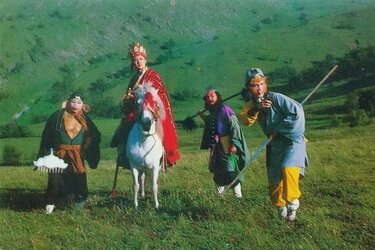
1986 Version of "Journey to the West"
Taking Sun Wukong as an example, his journey from a nameless stone monkey to the Great Sage Equal to Heaven, who causes havoc in Heaven, and then to the Monkey King on the journey for scriptures, represents a person's gradual process of socialization:
Initially, the stone monkey, "not recognized by heaven, not cared for by earth, and free and unrestrained," symbolizes the childhood of humanity. The stone monkey becomes dissatisfied with the status quo, leading to worries (or desires), which motivates him to seek a master and learn skills—before entering society, one must acquire various knowledge and skills.
With the name “Sun Wukong,” he gained the ability to perform seventy-two transformations and acquired the important weapon, the Golden Staff, from the Dragon Palace.
He developed the courage to rally with friends like the Bull Demon King in the mountains—similar to how big shots start their ventures from their garages. He entered the Heavenly Court and became the Stable Master—equivalent to being recruited by a big company. After causing havoc in Heaven, he was suppressed under the Five Elements Mountain—an individual with personality and capability openly challenging the big boss, yet the big boss remains the big boss.
He was assigned by Guanyin Bodhisattva to wear a golden hoop and protect Tang Seng on his journey to the West—switching tracks to enter a new company, where the leader lets things go and colleagues slack off, while he becomes a pioneering figure.
Although he calls himself the "Handsome Monkey King," Sun Wukong does not appear to be a great hero, at least in terms of his appearance— the Bull Demon King remarks that he is "less than four feet tall," and the princess of the Kingdom of Baoxiang calls him "a skinny ghost with more bones than muscles."
However, heroes are not defined by their looks or backgrounds. French thinker Romain Rolland defines heroes in his work "Three Giants" (which includes "Beethoven," "Michelangelo," and "Tolstoy") as those who "are not great because of their thoughts or strength, but simply because of their spirit."
In Romain Rolland's view, a hero is not someone who fights for individual purposes or to achieve great accomplishments, but rather someone who struggles for the whole and for life itself. He wrote, “There is only one kind of heroism in the world: to see the world as it is—and to love it.”

1986 Version of "Journey to the West"
Sun Wukong embodies the kind of person Romain Rolland refers to—someone who strives to overcome various difficulties and obstacles in life. He bravely experiences it all, as if undergoing a sort of examination of his heroism. A summary by Fu Lei, the translator of "Three Giants," also applies to Sun Wukong: “perseverance, struggle, and the courageous spirit to challenge the divine.”
The depiction of Sun Wukong in Jin Hezai’s "Wukong Biography" aligns with this notion. The first scene of the book features the four disciples being blocked by a dense forest. Tang Seng expresses his hunger and asks Sun Wukong to find something to eat. Sun Wukong replies that he is busy watching the evening clouds.
“'Don’t you think the sunset is beautiful?' Sun Wukong said, still gazing at the horizon, 'Only by enjoying this can I continue to head west every day.'"
A Journey to the West-Style Subversion
Among the Four Great Classical Novels, "Journey to the West" is arguably the most frequently adapted and remade work. Among these, the 1986 CCTV television series "Journey to the West" has had a profound impact and can be regarded as the "enlightenment" of the “one-child generation” regarding "Journey to the West."
Tang Seng is devout yet soft and hesitant; Sun Wukong is rebellious, unruly, and witty; Zhu Bajie is gluttonous and lecherous, with a narrow perspective; Sha Wujing has no remarkable skills but compensates with diligence; and the White Dragon Horse can step up in times of danger—this image of the "Five-Man Team" of the master and his disciples, along with the horse, has thus become ingrained in people's minds.
Consequently, the absurdist film "A Chinese Odyssey," released in 1995, signifies a subversion of concepts and perceptions for many. Scholar Bai Huiyuan stated in an interview, “Within a few years, the CCTV version of 'Journey to the West' established (Sun Wukong's) heroic idol for us, only to be dismantled later by Stephen Chow's 'A Chinese Odyssey.'”
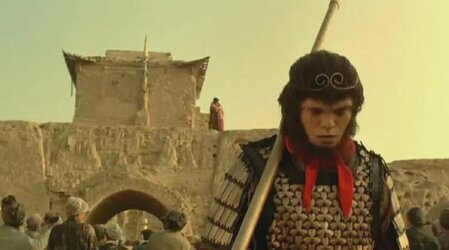
The Stephen Chow Version of "A Chinese Odyssey," Released in 1995
Bai Huiyuan also vividly remembers the first time he “encountered” "A Chinese Odyssey"—during the Spring Festival in 1997 when CCTV-6 re-aired the film. “Sun Wukong became a bandit with human emotions, trapped by inescapable worldly constraints, ultimately becoming ‘like a dog.’ This story evoked my initial despair towards the exam-oriented education system,” Bai Huiyuan recalled.
In fact, according to the analysis in the "A Chinese Odyssey Compendium" by Zhang Lixian and others, the film was a box-office failure when it was released in mainland China. Distribution managers from various film companies found it "too noisy and chaotic" and expressed their lack of confidence. Some audience members queued for a long time to enter the theater but complained vocally midway through, feeling they had been duped.
Having grown accustomed to the portrayal of the Great Sage Equal to Heaven by Liu Xiaolingtong, people found it difficult to accept Stephen Chow's rendition of the character.
Moreover, how could the eternally single Sun Wukong suddenly fall in love? Additionally, there were complaints about Lo Chih-hung's portrayal of the "long-winded" Tang Seng and the director Liu Zhenwei’s cameo as Patriarch Bodhi—what was up with Bodhi transforming into a bunch of grapes? No more dialect puns!
The craze around "A Chinese Odyssey" formed as it connected with youth subculture.
The Beijing Film Academy can be seen as one of the important dissemination points, where college students discovered that the lines from "A Chinese Odyssey" could seamlessly integrate into daily conversations. For instance, when someone asked why they loved watching "A Chinese Odyssey," they could respond: “Does loving a movie require a reason? No? Yes? ... Everyone is just doing some research; why take it so seriously?”
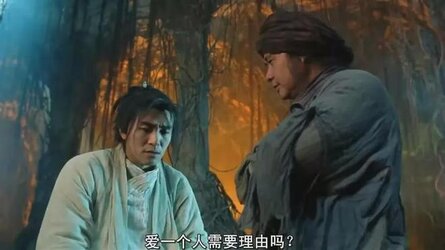
A Chinese Odyssey: Cinderella
In the 2013 film "Journey to the West: Conquering Demons," the image of Sun Wukong transformed into a "beastly" demon king. Bai Huiyuan found that many netizens believed this version of Sun Wukong was more in line with the original text, which shocked him and was emotionally hard for him to accept.
He felt that the direct reason for Sun Wukong’s "demonization" was the digital transformation and 3D technology; audiences desired a visually impactful experience that was "worth the ticket price," thus Sun Wukong became akin to a "King Kong."
In the Western cultural context, demon kings and monsters symbolize evil, alien forces that are the absolute 'Other'; "exorcists" are seen as conquerors.
Therefore, Bai Huiyuan argues that "Journey to the West: Conquering Demons" takes the perspective of the "exorcist," with Tang Sanzang's ultimate goal being to tame Sun Wukong, the monster. Consequently, "we have colluded with the social power structure—transforming the former 'rebel' into a clown, thereby losing the possibility of alternative choices."
The Modernity of the "Journey to the West" IP
When "Black Myth: Wukong" was released, "Dream of the Red Chamber: A Match Made in Heaven" was also airing. The latest derivative products from these two major IPs received mixed reviews. An industry insider noted that, comparatively, the biggest problem with the "Dream of the Red Chamber" IP is its lack of modernity.

Dream of the Red Chamber: A Match Made in Heaven
Using Baudrillard's framework for comparison, the IP products of 'Dream of the Red Chamber' remain caught between the first and second orders; the lower tier is merely imitation, while the better tier is just production, always leading to mere observation.
In contrast, the IP products of 'Journey to the West' consistently exist in the third order, capable not only of embedding in various postmodern contexts and connecting with more emotional threads across different eras, but also able to engage more people in constructing a shared 'hyperreal world,'" the industry insider wrote.
It is important to clarify Baudrillard's "three orders of simulacra": the first order is imitation, which was the dominant model from the Renaissance to the Industrial Revolution; the second order is production, the dominant model of the industrial era; and the third order is simulation, which is currently dominated by code.
Why can "Journey to the West" be embedded in various postmodern scenarios? For example, "Journey to the West" employs a travel structure, with the group of five journeying westward, facing the "eighty-one trials." This not only maintains a thrilling and engaging allure throughout the book, with a clear goal, but also allows for internal friction and conflict within the small group.
The former keeps the story exciting and focused, while the latter ensures character development and internal coherence. Therefore, whether adapted into a road movie or a coming-of-age novel, it feels perfectly fitting.
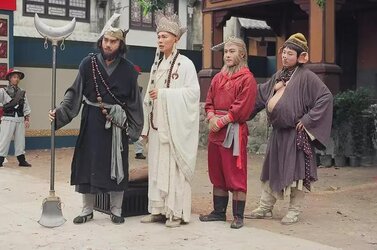
TVB's "Journey to the West" (1996)
In 2006, Spielberg expressed his intention to adapt "Journey to the West" into a road movie. However, to this day, we have yet to see that road movie materialize. As a result, media personality Wang Xiaofeng wrote an article imagining how Spielberg would direct "Journey to the West":
the story would begin with "The Three Encounters with the White Bone Spirit," briefly introducing the backgrounds of the four disciples. Then, the White Bone Spirit would make an appearance, creating a tense atmosphere and laying out the plot. The comedic duo of Sun Wukong and Zhu Bajie would perform like they are in a stand-up comedy act. Although no one likes Tang Seng, his role is crucial; he serves as a plot driver, much like the African leader Lin Bani in "Wild Geese Can't Die"…
Though it's fictional, some ideas might indeed help directors planning to adapt "Journey to the West," such as the comedic dynamic between Sun Wukong and Zhu Bajie, which could provide a lot of humorous moments.

"Return from the Journey to the West." This painting is a modern interpretation of the four disciples by the artist Chen Jianzhou
Italo Calvino, in "Why Read the Classics," states that when reading Turgenev's "Fathers and Sons" or Dostoevsky's "The Demons," one cannot help but ponder how the characters in these books continue to reincarnate and live on into our era.
The same can be said for "Journey to the West"; characters like Sun Wukong, who lived centuries ago, are recognized, understood, and embraced by generations of readers, as if they have crossed over to immerse themselves in our time.
Thus, in works like "Journey to the West ABC," if Sun Wukong transforms into a middle-aged man who gets married and has children, what is there to be surprised about? Such a version of Sun Wukong actually brings him emotionally closer to us.
By Taozi Jiang

Even those who don’t play games know that another “Wukong” has emerged—“You must have all heard the stories about him. Some say he helped the Tang monk obtain the true scriptures and was granted the title of Victorious Fighting Buddha, remaining in the Lingshan Mountains from then on.
Others say that the one who became a Buddha was not him at all; the real Wukong had long died on the journey to the West. Still, others say that 'Journey to the West' never actually happened; he is just a monkey invented by the storyteller.

Domestic AAA game masterpiece "Black Myth: Wukong"
This passage comes from the domestic AAA game masterpiece "Black Myth: Wukong." One of the effects of the game's popularity is the increase in reading the original "Journey to the West": on WeChat Reading, both "Journey to the West" and the book "Wukong Biography" by Jin Hezai have topped the trending list; on Amazon, the sales of the English version of "Journey to the West" have rapidly increased.
If we accept the claim that the original hundred-chapter edition of "Journey to the West" appeared during the early Jiajing period of the Ming Dynasty, then "Journey to the West" has been established for at least 500 years.
The "Journey" story, which took shape 500 years ago, especially the vibrant image of Sun Wukong, continues to resonate in modern and post-modern contexts through various media such as film and television, fan fiction, anime, and games. This is enough to demonstrate that this IP has a thriving cultural vitality.
True Heroism
The story of "Journey to the West" begins with the stone monkey, born from the "essence of heaven and earth," leaping over a waterfall and discovering the Water Curtain Cave in the Flower-Fruit Mountain paradise.
Just like Harry Potter passing through Platform 9¾ to enter the magical world from the real world, the stone monkey's leap foreshadows that readers are about to enter not the era of the Tang monk Xuanzang, the prototype of Tang Sanzang, but a mythical world where humans coexist with demons, spirits, ghosts, immortals, Buddhas, and gods.
Since it is a mythical world, where characters possess various supernatural powers, it allows for boundless imagination, providing space for future adaptations into visual forms. While this mythical world may seem ethereal and elusive, it is, in fact, a reflection of the secular world.
As Lu Xun said, “both gods and demons possess human emotions, and spirits and phantoms understand the ways of the world,” making it easier for readers to immerse themselves in the story and reinterpret it in terms of personal growth, teamwork, interpersonal relationships, and the complexities of human affairs.

1986 Version of "Journey to the West"
Taking Sun Wukong as an example, his journey from a nameless stone monkey to the Great Sage Equal to Heaven, who causes havoc in Heaven, and then to the Monkey King on the journey for scriptures, represents a person's gradual process of socialization:
Initially, the stone monkey, "not recognized by heaven, not cared for by earth, and free and unrestrained," symbolizes the childhood of humanity. The stone monkey becomes dissatisfied with the status quo, leading to worries (or desires), which motivates him to seek a master and learn skills—before entering society, one must acquire various knowledge and skills.
With the name “Sun Wukong,” he gained the ability to perform seventy-two transformations and acquired the important weapon, the Golden Staff, from the Dragon Palace.
He developed the courage to rally with friends like the Bull Demon King in the mountains—similar to how big shots start their ventures from their garages. He entered the Heavenly Court and became the Stable Master—equivalent to being recruited by a big company. After causing havoc in Heaven, he was suppressed under the Five Elements Mountain—an individual with personality and capability openly challenging the big boss, yet the big boss remains the big boss.
He was assigned by Guanyin Bodhisattva to wear a golden hoop and protect Tang Seng on his journey to the West—switching tracks to enter a new company, where the leader lets things go and colleagues slack off, while he becomes a pioneering figure.
Although he calls himself the "Handsome Monkey King," Sun Wukong does not appear to be a great hero, at least in terms of his appearance— the Bull Demon King remarks that he is "less than four feet tall," and the princess of the Kingdom of Baoxiang calls him "a skinny ghost with more bones than muscles."
However, heroes are not defined by their looks or backgrounds. French thinker Romain Rolland defines heroes in his work "Three Giants" (which includes "Beethoven," "Michelangelo," and "Tolstoy") as those who "are not great because of their thoughts or strength, but simply because of their spirit."
In Romain Rolland's view, a hero is not someone who fights for individual purposes or to achieve great accomplishments, but rather someone who struggles for the whole and for life itself. He wrote, “There is only one kind of heroism in the world: to see the world as it is—and to love it.”

1986 Version of "Journey to the West"
Sun Wukong embodies the kind of person Romain Rolland refers to—someone who strives to overcome various difficulties and obstacles in life. He bravely experiences it all, as if undergoing a sort of examination of his heroism. A summary by Fu Lei, the translator of "Three Giants," also applies to Sun Wukong: “perseverance, struggle, and the courageous spirit to challenge the divine.”
The depiction of Sun Wukong in Jin Hezai’s "Wukong Biography" aligns with this notion. The first scene of the book features the four disciples being blocked by a dense forest. Tang Seng expresses his hunger and asks Sun Wukong to find something to eat. Sun Wukong replies that he is busy watching the evening clouds.
“'Don’t you think the sunset is beautiful?' Sun Wukong said, still gazing at the horizon, 'Only by enjoying this can I continue to head west every day.'"
A Journey to the West-Style Subversion
Among the Four Great Classical Novels, "Journey to the West" is arguably the most frequently adapted and remade work. Among these, the 1986 CCTV television series "Journey to the West" has had a profound impact and can be regarded as the "enlightenment" of the “one-child generation” regarding "Journey to the West."
Tang Seng is devout yet soft and hesitant; Sun Wukong is rebellious, unruly, and witty; Zhu Bajie is gluttonous and lecherous, with a narrow perspective; Sha Wujing has no remarkable skills but compensates with diligence; and the White Dragon Horse can step up in times of danger—this image of the "Five-Man Team" of the master and his disciples, along with the horse, has thus become ingrained in people's minds.
Consequently, the absurdist film "A Chinese Odyssey," released in 1995, signifies a subversion of concepts and perceptions for many. Scholar Bai Huiyuan stated in an interview, “Within a few years, the CCTV version of 'Journey to the West' established (Sun Wukong's) heroic idol for us, only to be dismantled later by Stephen Chow's 'A Chinese Odyssey.'”

The Stephen Chow Version of "A Chinese Odyssey," Released in 1995
Bai Huiyuan also vividly remembers the first time he “encountered” "A Chinese Odyssey"—during the Spring Festival in 1997 when CCTV-6 re-aired the film. “Sun Wukong became a bandit with human emotions, trapped by inescapable worldly constraints, ultimately becoming ‘like a dog.’ This story evoked my initial despair towards the exam-oriented education system,” Bai Huiyuan recalled.
In fact, according to the analysis in the "A Chinese Odyssey Compendium" by Zhang Lixian and others, the film was a box-office failure when it was released in mainland China. Distribution managers from various film companies found it "too noisy and chaotic" and expressed their lack of confidence. Some audience members queued for a long time to enter the theater but complained vocally midway through, feeling they had been duped.
Having grown accustomed to the portrayal of the Great Sage Equal to Heaven by Liu Xiaolingtong, people found it difficult to accept Stephen Chow's rendition of the character.
Moreover, how could the eternally single Sun Wukong suddenly fall in love? Additionally, there were complaints about Lo Chih-hung's portrayal of the "long-winded" Tang Seng and the director Liu Zhenwei’s cameo as Patriarch Bodhi—what was up with Bodhi transforming into a bunch of grapes? No more dialect puns!
The craze around "A Chinese Odyssey" formed as it connected with youth subculture.
The Beijing Film Academy can be seen as one of the important dissemination points, where college students discovered that the lines from "A Chinese Odyssey" could seamlessly integrate into daily conversations. For instance, when someone asked why they loved watching "A Chinese Odyssey," they could respond: “Does loving a movie require a reason? No? Yes? ... Everyone is just doing some research; why take it so seriously?”

A Chinese Odyssey: Cinderella
In the 2013 film "Journey to the West: Conquering Demons," the image of Sun Wukong transformed into a "beastly" demon king. Bai Huiyuan found that many netizens believed this version of Sun Wukong was more in line with the original text, which shocked him and was emotionally hard for him to accept.
He felt that the direct reason for Sun Wukong’s "demonization" was the digital transformation and 3D technology; audiences desired a visually impactful experience that was "worth the ticket price," thus Sun Wukong became akin to a "King Kong."
In the Western cultural context, demon kings and monsters symbolize evil, alien forces that are the absolute 'Other'; "exorcists" are seen as conquerors.
Therefore, Bai Huiyuan argues that "Journey to the West: Conquering Demons" takes the perspective of the "exorcist," with Tang Sanzang's ultimate goal being to tame Sun Wukong, the monster. Consequently, "we have colluded with the social power structure—transforming the former 'rebel' into a clown, thereby losing the possibility of alternative choices."
The Modernity of the "Journey to the West" IP
When "Black Myth: Wukong" was released, "Dream of the Red Chamber: A Match Made in Heaven" was also airing. The latest derivative products from these two major IPs received mixed reviews. An industry insider noted that, comparatively, the biggest problem with the "Dream of the Red Chamber" IP is its lack of modernity.

Dream of the Red Chamber: A Match Made in Heaven
Using Baudrillard's framework for comparison, the IP products of 'Dream of the Red Chamber' remain caught between the first and second orders; the lower tier is merely imitation, while the better tier is just production, always leading to mere observation.
In contrast, the IP products of 'Journey to the West' consistently exist in the third order, capable not only of embedding in various postmodern contexts and connecting with more emotional threads across different eras, but also able to engage more people in constructing a shared 'hyperreal world,'" the industry insider wrote.
It is important to clarify Baudrillard's "three orders of simulacra": the first order is imitation, which was the dominant model from the Renaissance to the Industrial Revolution; the second order is production, the dominant model of the industrial era; and the third order is simulation, which is currently dominated by code.
Why can "Journey to the West" be embedded in various postmodern scenarios? For example, "Journey to the West" employs a travel structure, with the group of five journeying westward, facing the "eighty-one trials." This not only maintains a thrilling and engaging allure throughout the book, with a clear goal, but also allows for internal friction and conflict within the small group.
The former keeps the story exciting and focused, while the latter ensures character development and internal coherence. Therefore, whether adapted into a road movie or a coming-of-age novel, it feels perfectly fitting.

TVB's "Journey to the West" (1996)
In 2006, Spielberg expressed his intention to adapt "Journey to the West" into a road movie. However, to this day, we have yet to see that road movie materialize. As a result, media personality Wang Xiaofeng wrote an article imagining how Spielberg would direct "Journey to the West":
the story would begin with "The Three Encounters with the White Bone Spirit," briefly introducing the backgrounds of the four disciples. Then, the White Bone Spirit would make an appearance, creating a tense atmosphere and laying out the plot. The comedic duo of Sun Wukong and Zhu Bajie would perform like they are in a stand-up comedy act. Although no one likes Tang Seng, his role is crucial; he serves as a plot driver, much like the African leader Lin Bani in "Wild Geese Can't Die"…
Though it's fictional, some ideas might indeed help directors planning to adapt "Journey to the West," such as the comedic dynamic between Sun Wukong and Zhu Bajie, which could provide a lot of humorous moments.

"Return from the Journey to the West." This painting is a modern interpretation of the four disciples by the artist Chen Jianzhou
Italo Calvino, in "Why Read the Classics," states that when reading Turgenev's "Fathers and Sons" or Dostoevsky's "The Demons," one cannot help but ponder how the characters in these books continue to reincarnate and live on into our era.
The same can be said for "Journey to the West"; characters like Sun Wukong, who lived centuries ago, are recognized, understood, and embraced by generations of readers, as if they have crossed over to immerse themselves in our time.
Thus, in works like "Journey to the West ABC," if Sun Wukong transforms into a middle-aged man who gets married and has children, what is there to be surprised about? Such a version of Sun Wukong actually brings him emotionally closer to us.


